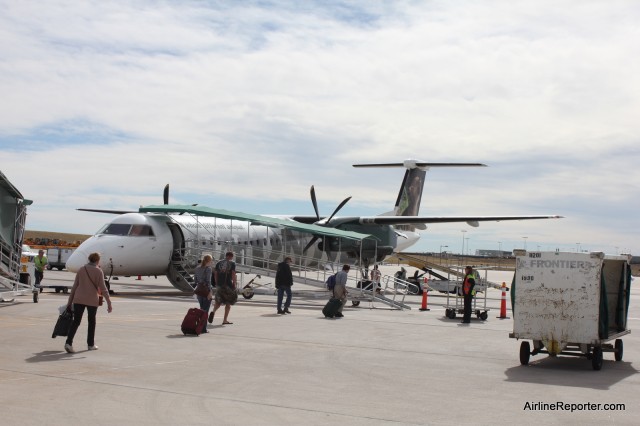
Frontier Bombarider Q400 (N502LX) sits at Denver, waiting to take me to Aspen.
Being based in Seattle, I have had plenty of opportunities flying on Bombardier Q400s via Horizon Air Alaska Airlines. When I had the opportunity to recently fly from Seattle to Aspen, for a ride on a Beechcraft Starship, I did not have too many choices on what to fly from Denver (DEN) to Aspen (ASE). I could either fly on a United Airlines CRJ 700 (operated by Skywest) or a Frontier Airlines Q400 (operated by Lynx Aviation). Being the aviation fan that I am, I chose my airline based on the aircraft type and wanted to experience the Q400 flying into Denver — lucky for me, it was the cheaper of the two tickets as well.
When landing at DEN from Seattle (SEA), I had about an hour and a half layover. This was a good thing, since the Q400s are located pretty much at the end of the airport, down some stairs and at the end of a very long and narrow hallway. I kind of wish I would have spent more time in the main terminal, since the waiting area for regional flight do not have too much to offer.
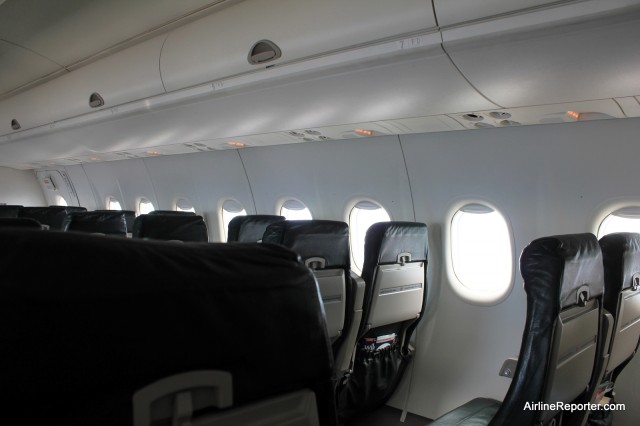
The Q400 is not known for being very roomy, but this flight was almost empty, so I had plenty of room.
Our flight was pretty empty, with about 20 people flying on the 70 passenger aircraft. Boarding was easy with one announcement made for people to start boarding and it only took a few minutes. One of the attractive parts about flying on a regional carrier is the increased chance of boarding on the tarmac. Although most air travelers probably hate boarding this way, for an airline fan, nothing can beat it.
When boarding there was a cart that passengers could put their carry-ons to be placed in the cargo-hold and not in the cabin. All I had was a back-pack, so I opted to bring that on board… bad call. Even though it was small (in carry-on standards) it still wouldn’t fit in the overhead bin. Lucky for me, I had no problems storing under an empty seat, but if the plane was full, stuffing a back-pack under my seat would have really taken a lot of my space.
For weight distribution, everyone sat near the back of the plane. I was in row 7 and I was the farthest to the front and there was no one even around me.
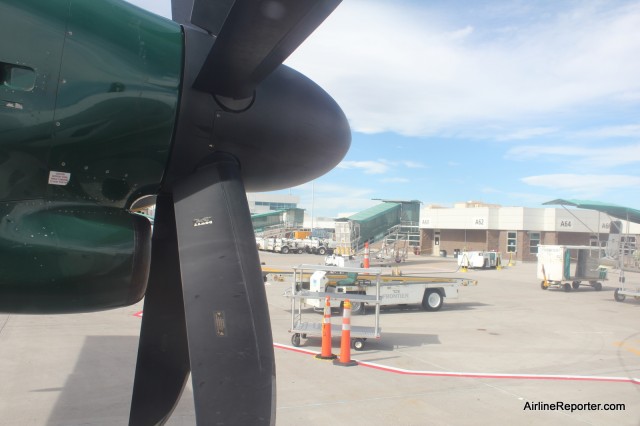
Many passengers might not enjoy this view when looking outside, but I love it.
Unlike Alaska’s Q400s, Frontier’s have sun screens and the seats are able to recline. Sure, nice touches, but this flight was only about 45 minutes, so these features meant little to me.
Engine start up on a turboprop is always my favorite part of the flight and those sweet Pratt & Whitney PW150A engines did not disappoint. Being in row 7, I had a favorable view watching them slowly start up and hearing the growl of the engines. Again, maybe not something the majority of passengers would enjoy, but it is one of the reasons I choose to fly on a Q400 when I have other options.
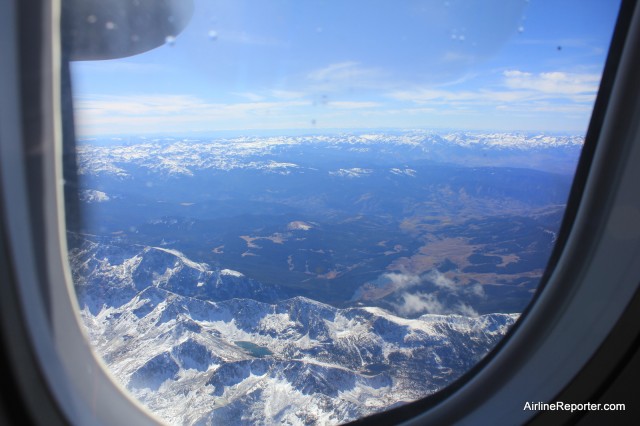
The views flying from Denver to Aspen were prettying amazing. Flying low in the Q400 sure helped.
As I normally do, I had my camera at the ready to take photos as we took off. Yes, you can yell at me for keeping an electronic on while taking off, but there is no way that a camera is going to affect an airplane. It is very rare for a flight attendant to say something, but this was one of those flights. I was told that I had to turn off my camera and had to wait until we reached 10,000 feet before turning it on… sigh — okay fine. I may not agree with the rules, but I am not going to argue with the person just trying to do their job.
We were also told that we would not be able to turn on our cell phones during the entire flight. Not just airplane mode, but it couldn’t be on at all. My guess is that since we never flew very high, we would still be able to get reception during the flight and possibly cause interference. Either way, I listened and kept my phone off and enjoyed the view out the window.
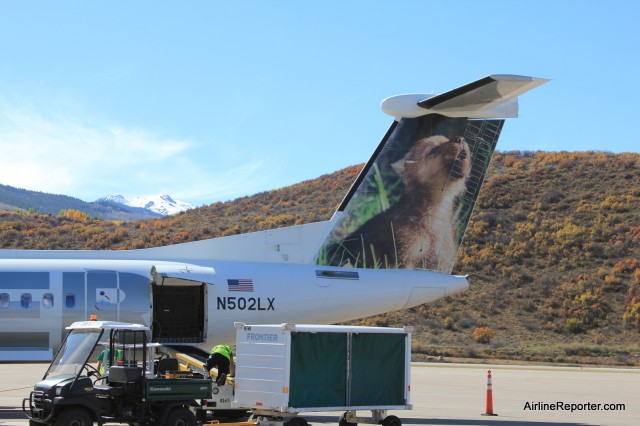
This wolf pup's name is Wolfgang and he looks pretty much at home in Aspen.
The short flight was pretty bumpy, especially near the end. Again, most people probably wouldn’t like the idea of flying on a turboprop in turbulence, but I actually kind of enjoy it . It was obvious that this plane had been in turbulence before. Even when the bumps were not that bad, but the overhead bins were shaking like it was a huge storm and competed with the engines on making the most noise.
The weather got worse as we got closer to ASE and with the rapid descent, the flight attendants did not even get up to do their final safety check, but asked us to make sure our seats were up and belts buckled for landing. Okay, I can understand that, but they never got up during the entire flight anyhow. Not that I need a drink during a 45 minute flight, but at least getting up once to check on the passengers would probably be a good idea, instead of sitting in your jump seat chit-chatting with each other.
Flying into Aspen was quite beautiful and a bit aggressive. We bounced around as heading down at a steep angle to make it into the airport. As an aviation lover, this flight was great, but I could see how most people would not think the same way. But, if you are looking to fly into Aspen, you do not have much of a choice, other than flying on a CRJ700 or a private plane. Good thing I love flying and most people are willing to do it to experience Aspen.
A few more photos of my Frontier Q400 flight…
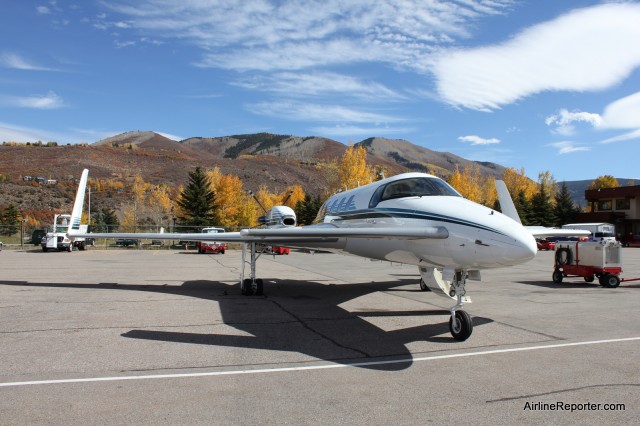
The 51st Starship N514RS sits in Aspen, CO (ASE) before our flight.
For many reasons the Raytheon Beechcraft Starship is a unique aircraft. It is hard to imagine that the initial design phase for the Starship started in the late 1970’s. To say that the Starship was ahead of its time is an understatement and even today, it is one impressive machine. The aircraft holds the record for quite a few “firsts:”
* First composite corporate aircraft
* First certified all glass cockpit
* First certified canard wing aircraft
* First certified pusher design
The innovations caused a lot of skepticism from the FAA who was in charge of certifying the aircraft as safe to fly. Due to some overzealous precautions, the Starship ended up 2500lbs heavier than originally planned. The hope was the Starship would have a max cruise of 352kts and able to go 2500nm, but instead it had a max cruise of 338kts and with a range of 1575nm.
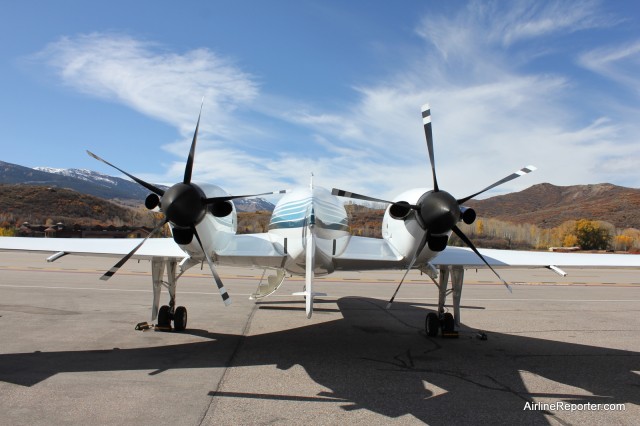
Since the Starship is a pusher aircraft, it keeps the cabin quiet.
So, why wouldn’t a plane so ahead of its time sell well? There is no simple answer. When the Starship first went on sale in 1989, it was a tough economic market and few companies and individuals were looking for a private business aircraft. The Starship was priced about the same as entry level jets and many people were wary of the radical design. After three years of being certified, only 11 Starships were sold. Raytheon, which purchased Beechcraft in 1980, was looking for creative ways to build confidence with potential customers and offered free maintenance for the aircraft.
Even with the upturn in the economy in the early 1990s and with the assurance of the maintenance program, Raytheon sold only produced 50 for sale (which only about half were sold) and 3 were built for the certification program. It would have made sense for the company to continue to invest in the Starship, but instead, they pulled the plug. Not only did they stop producing Starships, but they also tried to buy back all that were sold to have them destroyed. Luckily, not every owner agreed and today there are still five Starships that remain flyable, another five that are on display at different locations, 24 have been destroyed and the rest are used for different purposes.
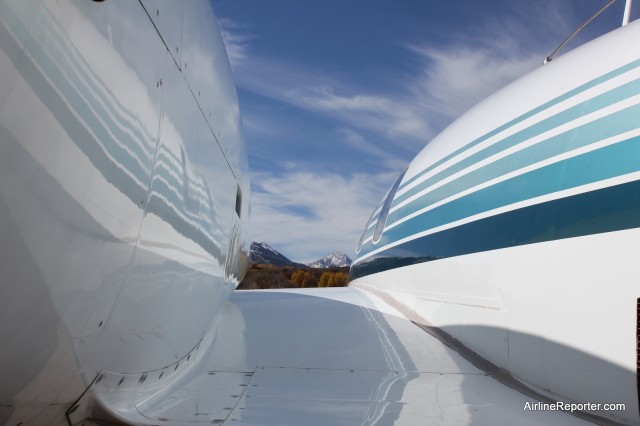
The Starship has such gorgeous lines. The Aspen background doesn’t hurt either.
During a sleepless night in April 2010, I sat watching Starship videos and thought of the idea to start my quest to get a ride in a Beechcraft Starship. I thought it was a pretty lofty goal and wasn’t sure how it was going to turn out, but I wanted to give it a shot. However, with a lot of luck, I was able to connect with Robert Scherer, owner of NC-51 (reg: N514RS – get it? (51) NC-51 (4) for (RS) Robert Scherer – nice).
Robert and I were able to meet up at Oshkosh 2010 and he graciously gave me a tour of his Starship NC-51. Even though she was stuck in the corner of a hangar, she looked beautiful. Then, in January 2011, Robert invited me to take a flight from Aspen to Orange County, CA, but when I got to Denver, my flight to Aspen was cancelled due to snow — sigh.
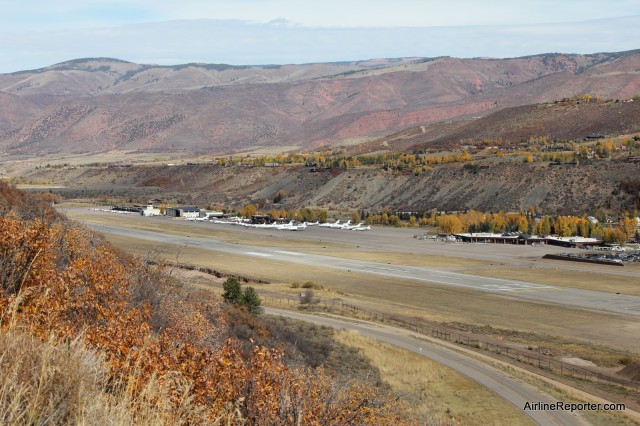
Aspen ’“ Pitkin County Airport (ASE) looks great. Check out all that heavy metal. Can you find the Starship? (click for larger)
Then another opportunity arose on the 16th of October. After having issues with the snow last time, I did not want to take any chances, so I decided to arrive a day early and spend the night in Aspen, even though Robert was heading out early afternoon on Sunday. Since we weren’t heading out until 1pm on Sunday, it gave me a chance to check out the Aspen Pitkin County Airport (ASE) earlier in the morning.
Just seeing the Starship through the fence when I first arrived was exciting. I had the chance to take photos around the Starship on the tarmac before it was time to board. There are six very nice seats in the back of the aircraft, but the two best are up front, and I had dibs on the right seat.
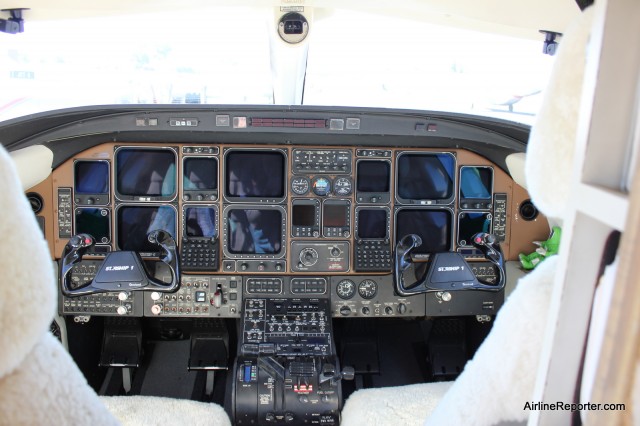
The Starship dashboard looks good unlit. I was excited to get into the right seat.
Finally, it was time to power up those beautiful Pratt & Whitney Canada PT6A-67A turboprop engines. From a fan’s point of view, one small downside of the Starship is you can’t watch the blades start up and really, you can’t hear them either. I was wondering when Robert was going to start the engines and he told me they were already going. Sure enough; I checked the instruments and they were running. I took off my headphones and the air coming out of the dash board was louder than the engines — pretty awesome.
The Starship has a built-in electronic checklist and Robert went step-by-step checking everything to prepare the Starship for flight. I had seen photos and knew the Starship had a glass cockpit, but I had to keep reminding myself that they were produced in the early 80’s, not more recently. I became so distracted with the instruments, that I didn’t realize we were on the move — heck yes!
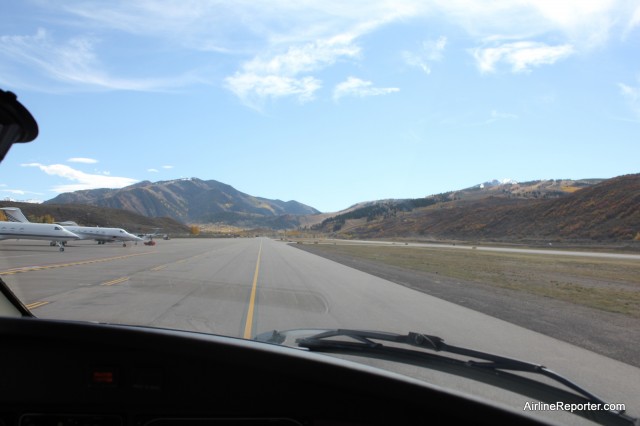
Taxi time in the Starship at Aspen.
As we taxied out, Robert was testing the all the control services and whoa — the canards started moving. I didn’t realize this previously, but they sweep about 35 degrees depending on the flap settings. This whole time I had been trying to reign in my giddiness, but it was pretty difficult after finding out the canards moved (do not worry, I got it on video, which I will be sharing in a future story).
When we went full throttle and took off from Aspen, you couldn’t wipe the grin off my face. This is what it’s all about — flying. It is hard to describe what it’s like flying in an airplane you have admired for most of your life.
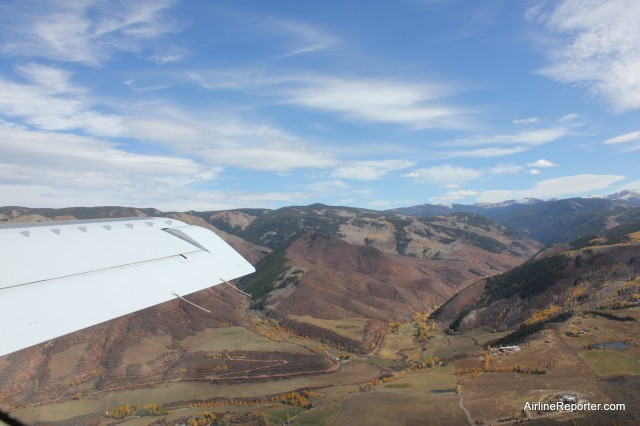
The canards are quite large and make photos of Aspen even better.
Flying out of Aspen provided some pretty nice views. Whenever I take photos from an airplane, I try to get a part of the aircraft in the shot to give a true sense of flight. The Starship makes it easy; one can get shots out the front with the canards or look back and get a shot with the wing.
Although the Starship is a smaller aircraft, it flies up with the big boys. The pressurized cabin provides a very comfortable climb to 32,000 feet. We were hoping to avoid turbulence, but it got a little bumpy after we reached altitude. Although most people do not enjoy bumps, this provided me with the opportunity to see how the Starship handles turbulence. In the Starship, it’s like riding a wave, not as much of the jerky bouncing and due to the flexing of the carbon fiber main wing, the high wing loading of the forward wing and the fact that your seated between the two wings.

We start our decent over Lake Powell.
Our flight plan included a stop in Page, AZ (PGA) for fuel. Now, the question was, should we go on a normal and boring approach into the airport or fly over Lake Powell up into Page? Yea, let’s go up the lake… what a great call!
Although I was enjoying every second of flying above the lake, I was bummed that there weren’t more boats down below to enjoy it as well. Could you imagine relaxing on your boat on the lake and then all of a sudden having a Beechcraft Starship fly overhead? Even if you were not an aviation fan, that would be quite a cool thing to see.
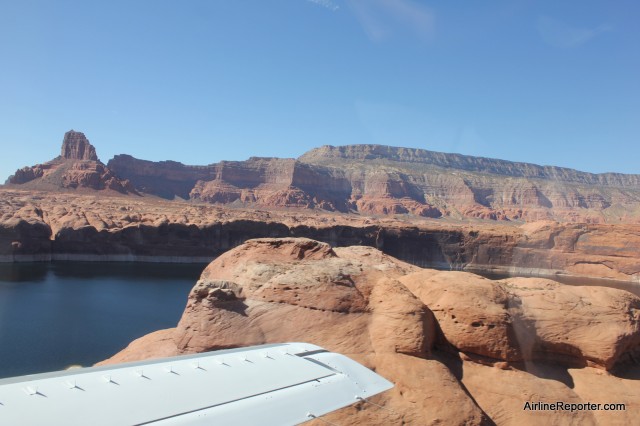
If photographs are worth a 1000 words, this has got to be worth at least 10,000. Flying over Lake Powell, on our way into Page, AZ.
When we landed at Page to get fuel, two pilots with Great Lakes Airlines came out and watched us taxi. One of the airport workers came running out and broke out his camera. It felt like we were superstars and Robert explained this is quite common. One of the pilots was elated, saying he never thought he would actually see a Starship. Robert was very gracious and welcomed them both to go check out his aircraft while we headed inside for some shade.
After about an hour on the ground, it was time to continue our journey to Orange County, CA. Right after we took off, we made a turn right over Glen Canyon Dam, and damn, does it look small from the Starship.
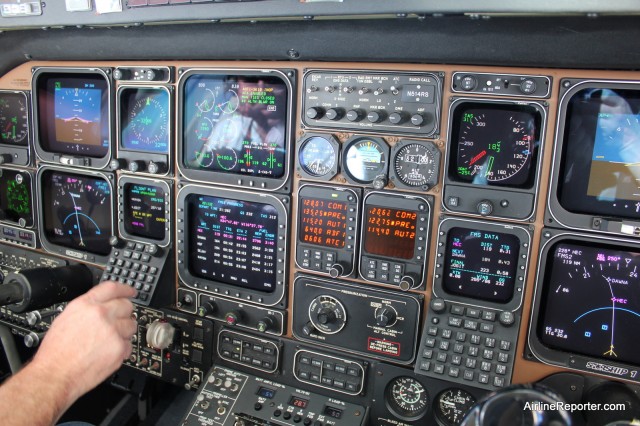
Cruising at 32,000 feet to Orange County, CA (SNA). Notice that the yellow “stick” Starship on the right has canards.
Back up to about 32,000 feet, heading towards our destination: SNA. The rest of our flight was smooth and uneventful — well as uneventful as flying in a Starship can be. Even after the three hour flight (we had head winds over 90kts), I was in awe of this plane.
The Starship is more than just a unique aircraft. For those who love aviation, it is a golden jewel. Since I have started writing about the plane, I have received many emails from folks sharing their stories about their experiences with Starships; from those who have seen them fly overhead to previous owners who explained that they have regretted giving up their Starship. Many folks have even had false sightings, where they think they see a Starship, but really it is a similarly configured Piaggio P.180 Avanti.
A huge thank you to Robert and his family for allowing me to hitch a ride. It was truly an amazing experience that I will not soon forget.
ALL 60 PHOTOS OF MY STARSHIP FLIGHT
My Quest to Ride on a Beechcraft Starship:
IDEA | CONNECT | TOUR | FLIGHT-PLAN | FAIL | FLIGHT | PHOTOS | VIDEO
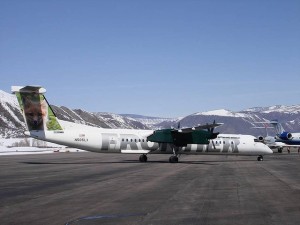
A Frontier Q400 at Aspen. Check the Delta and United planes in the background.
Remember that one time, when I told you that Frontier and Delta would pull out of Aspen, leaving only United Airlines? Yea, now that is only partly true. Delta is still out of there, but Frontier will be sticking around for at least a while.
The same day that Frontier announced it would stick around at least through the winter, United announced it would add additional service.
Frontier was planning to be rid of their fleet of Q400’s that fly into Aspen, but due to leasing issues, three aircraft will remain available to fly for Frontier.
Who is this good for? Well surely the employees for Frontier who were told they were out of a job starting September 30th and now have work until April. It also is good for passengers, since the competition will surely keep fares lower. Probably United is the only one who comes out of this in a worse position. They assumed that they would become the only airline in town and started to increase flight accordingly.
Source: Aspen Times Image: frontierflickr
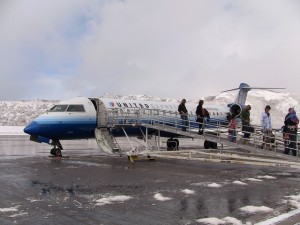
United Express CRJ-700 operated by SkyWest in Aspen (N724SK)
The beautiful resort town of Aspen! It might be beautiful year round, but most people will associate amazing skiing and snow with the town. To help bring skiers each year, three major airlines served the Aspen-Pitkin County Airport, but this ski season, there will only be one.
Frontier Airlines has been serving the town since 2008, using Q400’s. With Frontier’s new parent company, Republic Airways, wanting to phase out the Q400’s, they don’t feel it makes economic sense to fly their Embraer aircraft to the resort town.Frontier were trying to sell tickets over the winter to prove the route could be profitable, but they have decided to discontinue service as of September 30th.
Delta flew to Aspen from Salt Lake City and Atlanta and feel continuing the flights just doesn’t make economic sense.
Just because only one airline remains, don’t assume Aspen will turn into a ghost town. Even with the departure of Frontier and Delta, the town will only be losing 20% of their seating capacity. United Express will still be flying 12 daily flights from Denver this winter as well as three each from Chicago and Los Angeles and one daily from San Francisco.
The airport is planning a 1000 foot runway expansion in an effort to lure back Frontier and Delta. Since both airlines don’t see the economics with the smaller aircraft they are flying now, I am not quite sure how a longer runway will increase possible passenger loads.
Source: Denver Business Journal Image: Carrera Turbo
















